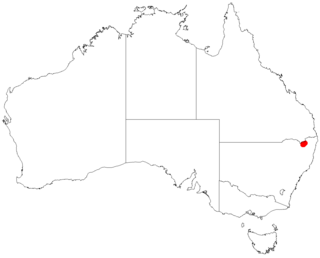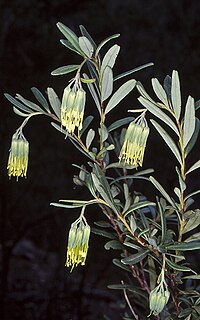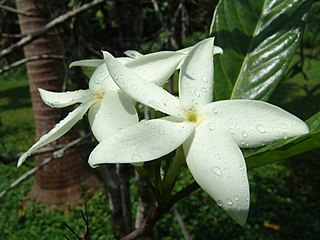
Melicope elleryana, commonly known as pink flowered doughwood, pink evodia, corkwood, or saruwa, is a species of rainforest shrub or tree in the family Rutaceae, and is native to New Guinea, parts of eastern Indonesia, the Solomon Islands and northern Australia. It has trifoliate leaves and pink to white, bisexual flowers arranged in panicles in leaf axils.

Phaleria clerodendron, commonly known as scented daphne, scented phaleria or rosy apple, is an evergreen tree or tall shrub in the family Thymelaeaceae. It is endemic to the rainforests of north-eastern Queensland, Australia.

Adenanthos detmoldii, commonly known as Scott River jugflower or yellow jugflower, is a species of shrub in the family Proteaceae. It is endemic to the south-west of Western Australia.

Phaius tankervilleaevar.australis, also known as the common swamp orchid, southern swamp-orchid, swamp lily or island swamp-orchid, is a species of orchid endemic to eastern Australia. It is an evergreen, terrestrial herb with large, crowded pseudobulbs, large pleated leaves and flowers that are reddish brown on the inside and white outside.

Leionema elatius, commonly known as tall phebalium, is a shrub species that is endemic to New South Wales and Queensland in Australia. It has glossy green, variably-shaped leaves and clusters of white-lemon flowers in spring.

Prostanthera walteri, commonly known as blotchy mint-bush, is a species of flowering plant that is endemic to south-eastern Australia. It is a sprawling shrub with tangled, hairy branches, egg-shaped leaves and usually bluish green flowers with prominent purple veins arranged singly in leaf axils.

Bosistoa pentacocca, commonly known as ferny-leaf bosistoa, native almond or union nut, is a species of tree that is endemic to eastern Australia. It has pinnate leaves arranged in opposite pairs with between three and thirteen leaflets and panicles of small flowers arranged in leaf axils or on the ends of branches. It grows along streams in rainforest.

Cassinia subtropica, commonly known as bushy rosemary, is a species of flowering plant in the family Asteraceae and is endemic to north-eastern Australia. It is shrub with woolly-hairy stems, lance-shaped to egg-shaped leaves and panicles of flower heads.

Persoonia acicularis is a species of flowering plant in the family Proteaceae and is endemic to the west coast of Western Australia. It is a shrub with linear, sharply-pointed leaves and yellow flowers in groups of up to eighty.
Persoonia brachystylis is a species of flowering plant in the family Proteaceae and is endemic to a restricted area on the west coast of Western Australia. It is an erect, spreading shrub with smooth bark, narrow spatula-shaped to lance-shaped leaves and yellow flowers in groups of ten to twenty.

Prostanthera staurophylla, commonly known as Tenterfield mint-bush, is a species of flowering plant in the family Lamiaceae and is endemic to a small area on the New England Tableland of New South Wales. It is an erect to spreading, strongly aromatic shrub with hairy branches, deeply lobed leaves and bluish-mauve flowers with darker markings.

Corymbia torelliana, commonly known as cadaghi or cadaga, is a species of tree that is endemic to north Queensland. It has smooth, greenish grey to white bark, rough at the base of older trees, egg-shaped, heart-shaped or lance-shaped adult leaves, flower buds in groups of three or seven, white flowers and urn-shaped or shortened spherical fruit.

Petrophile megalostegia is a species of flowering plant in the family Proteaceae and is endemic to southwestern Western Australia. It is a shrub with needle-shaped or flattened, sometimes S-shaped leaves with a sharply-pointed tip, and more or less cylindrical heads of silky-hairy, yellow to cream-coloured flowers.

Isopogon crithmifolius is a species of plant in the family Proteaceae and is endemic to the south-west of Western Australia. It is a shrub with divided leaves and more or less spherical heads of glabrous reddish pink flowers.

Isopogon tridens, commonly known as the three-toothed coneflower, is a species of flowering plant in the family Proteaceae and is endemic to the southwest of Western Australia. It is a shrub with wedge-shaped leaves with two or three sharply-pointed teeth, and flattened-spherical heads of glabrous creamy white, sometimes purple flowers.

Leionema ralstonii, is a small shrub with angular, smooth branchlets and pale green flowers in winter. It is restricted to the south coast of New South Wales.

Flindersia bourjotiana, commonly known as Queensland silver ash, northern silver ash, or white ash, is a species of tree that is endemic to Queensland. It has pinnate leaves arranged in opposite pairs and with between four and eight narrow egg-shaped to elliptic leaflets, greenish white flowers arranged in panicles, and fruit studded with short, rough points.

Olearia oppositifolia is a species of flowering plant in the family Asteraceae and is endemic to eastern Australia. It is a shrub with egg-shaped to elliptic leaves arranged in opposite pairs, and white and yellow daisy flowers.

Dicrastylis lewellinii is a species of plant within the genus, Dicrastylis, in the family Lamiaceae. It is found in Western Australia, the Northern Territory, New South Wales, Queensland and South Australia.

Atractocarpus hirtus, commonly known as the hairy gardenia or native loquat, is a plant in the madder family Rubiaceae, a large family of some 6,500 species with a cosmopolitan distribution. This species is endemic to north-east Queensland, Australia.




















